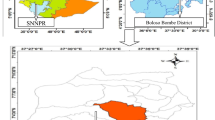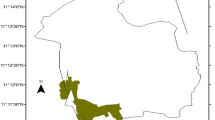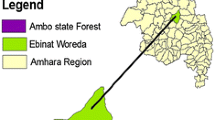Abstract
44 isolated ancient woods (9,3–8579 ha) in southeastern Lower Saxony (northwestern Germany), where the Tertiary hilly country meets the Pleistocene plain, were investigated. Complete lists of 273 vascular plant species showing a more or less strong preference for woodlands were made for each wood including all the species of the groups Querco-Fagetea, Trifolio-Geranietea, Galio-Calystegietalia (selection of species) and Epilobietea. The majority of character species of woods show either a low or a high frequency, whereas fewer ones have medium frequencies. Most of the rarer species have their main occurrence in the larger woods. The number of species of all of the four groups increases with area of the wood and the correlation between the number of species and the log of area is related by a highly significant linear regression. Comparison of a single wood with two smaller woods of the same total area reveals that the two smaller woods on average have the greater number of wood species. Considering this and the fact that the rarer species have their main occurrence in the larger woods, when discussing questions of nature conservation a simple comparison of number of species and area is problematical.
Similar content being viewed by others
References
Arrhenius, O. 1921. Species and area. J. Ecol. 9: 95–99.
Arrhenius, O. 1923. On the relation between species and area — a reply. Ecology 4: 90–91.
Becher, R. & Brandes, D. 1985. Vergleichende Untersuchungen an städtischen und stadtnahen Gehölzbeständen am Beispiel von Braunschweig. Braunschw. Naturk. Schr. 2: 309–339.
Brandes, D. 1984. Die Flora von Braunschweig um 1650 im Spiegel des ‘Index plantarum’ von Johann Chemnitius. Braunschw. Naturk. Schr. 2: 1–18.
Chemnitius, J. 1652. Index plantarum circa Brunsvigam trium ferè milliarum circuitu nascentium cum appendice iconum. Brunsvigae. (Reprint 1982 by Verlag J. Cramer. Braunschweig).
Cole, B. J. 1981. Colonizing abilities, island size, and the number of species on archipelagoes. Am. Nat. 117: 629–638.
Connor, E. F. & McCoy, E. D. 1979. The statistic and biology of the species-area relationship. Am. Nat. 113: 791–833.
Deshaye, J. & Morisset, P. 1989. Species-area relationships and the SLOSS effect in a subarctic archipelago. Biol. Conserv. 48: 265–276.
Dwzonko, Z. 1989. The number and distribution of woodland vascular plant species in small fores islands on the Carpathian foothills. Stud. Plant Ecol. 18, pp. 67–68.
Dwzonko, Z. & Loster, S. 1988. Species richness of small woodlands of the western Carpathian foothills. Vegetatio 76: 15–27.
Dzwonko, Z. & Loster, S. 1989. Distribution of vascular plant species in small woodlands on the West Carpathian foothills. Oikos 56: 77–86.
Ehrendorfer, F. 1973. Liste der Gefäßpflanzen Mitteleuropas, 2. erw. Aufl. Gustav Fischer Verlag, Stuttgart.
Game, H. & Peterken, G. F. 1984. Nature reserve selection strategies in the woodlands of Central Lincolnshire, England. Biol. Conserv. 29: 157–181.
Görges, H. 1969. Forstliche Wuchsbezierke in Niedersachsen. N. Arch. f. Nds. 18: 27–45.
Haeupler, H. 1974. Statistische Auswertung von Punktrasterkarten der Gefäßpflanzenflora Süd-Niedersachsens. Verlag Erich Goltze, Göttingen. (Scripta Geobotanica 8).
Haeupler, H. & Schönflder, P. 1988. Atlas der Farn- und Blütenpflanzen der Bundesrepublik Deutschland. Eugen Ulmer. Stuttgart.
Harris, L. D. 1984. The fragmented forest. The University of Chicago Press, Chicago.
Hermy, M. 1989. Former land use and its effect on the composition and diversity of woodland communities in the western part of Belgium. Stud. Plant Ecol. 18, pp. 104–105.
Hermy, M. & Stieperaere, H. 1981. An indirect gradient analysis of the ecological relationships between ancient and recent riverine woodlands to the south of Bruges (Flanders, Belgium). Vegetatio 44: 43–49.
Higgs, A. J. 1981. Island biogeography theory and nature reserve design. J. Biogeogr. 8: 117–124.
Higgs, A. J. & Usher, M. B. 1980. Should nature reserves be large or small?. Nature 285: 568–569.
Järvinen, O. 1982. Conservation of endangered plant populations: single large or several small reserves? Oikos 38: 301–307.
Janßen, Ch. & Brandes, D. 1984. Struktur und Artenvielfalt von Randzonen der Großstädte. Dargestellt am Beispiel von Braunschweig. Braunschw. Naturk. Schr. 2: 57–97.
Kubikova, J. 1987. Cultivated forest stands in Central Bohemia, their floristic composition and history. Martin Luther Univ. Halle Wittenberg: Wiss. Beitr. 1987/46 (P 31): 155–165d.
Levenson, J. B. 1981. Woodlots as biogeographic islands in South-eastern Wisconsin. In: Burgess, R. L. & Sharpe, D. M. (eds.), Forest island dynamics in man-dominated landscapes, pp. 13–39. Springer, Berlin.
MacArthur, R. H. & Wilson, E. O. 1967. The theory of island biogeography. Princeton University Press, Princeton.
Oderdorfer, E. 1987. Süddeutsche Wald- und Gebüschgesellschaften im europäischen Rahmen. Tuexenia 7: 459–468.
Peterken, G. F. 1981. A method for assessing woodland flora for conservation using indicator species. Biol. Conserv. 6: 239–245.
Peterken, G. F. & Game, M. 1984. Historical factors affecting the number and distribution of vascular plant species in the woodlands of Central Lincolnshire. J. Ecol. 72: 155–182.
Scanlan, M. J. 1981. Biogeography of forest plants in the prairie-forest ecotone in western Minnesota. In: Burgess, R. L. & Sharpe, D. M. (eds.), Forest island dynamics in man-dominated landscapes, pp. 97–124. Springer, Berlin.
Simberloff, D. & Abele, L. G. 1976. Island biogeography theory and conservation practice. Science NY 191: 285–286.
Simberloff, D. & Gotelli, N. 1984. Effects of insularisation on plant species richness in the prairie-forest ecotone. Biol. Conserv. 29: 27–46.
Soulé, M. E. & Simberloff, D. 1986. What do genetics and ecology tell us about the design of nature reserves? Biol. Conser. 35: 19–40.
van der Maarel, E. 1981. Biogeographical and landscape-ecological planning of nature reserves. In: Proc. Int. Congr. Neth. Soc. Landscape Ecol., pp. 227–235. Pudoc, Wageningen.
van der Maarel, E. 1988. Vegetation dynamics: patterns in time and space. Vegetatio 77: 7–19.
Zacharias, D. & Brandes, D. 1989. Floristical data analysis of 44 isolated woods in northwestern Germany. Stud. Plant Ecol. 18, pp. 278–280.
Zacharias, D., Janßen, Ch. & Brandes, D. 1988. Basenreiche Pfeifengras-Streuewiesen des Molinietum caeruleae W. Koch 1926, ihre Brachestadien und ihre wichtigsten Kontaktgesellschaften in Südost-Niedersachsen. Tuexenia 8: 55–78.
Zar, J. H. 1984. Biostatistical analysis, 2nd edn. Prentice-Hall, Englewood Cliffs, NJ.
Author information
Authors and Affiliations
Rights and permissions
About this article
Cite this article
Zacharias, D., Brandes, D. Species area-relationships and frequency — Floristical data analysis of 44 isolated woods in northwestern Germany. Vegetatio 88, 21–29 (1990). https://doi.org/10.1007/BF00032600
Accepted:
Issue Date:
DOI: https://doi.org/10.1007/BF00032600




